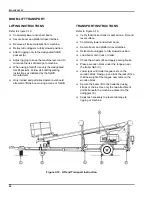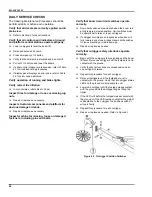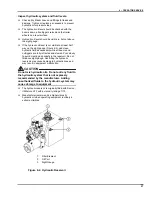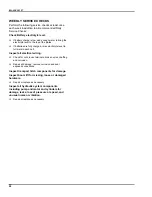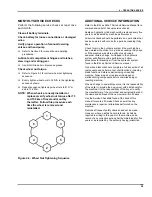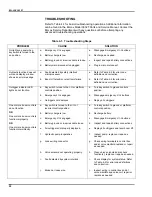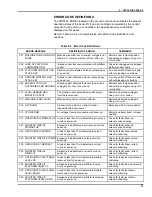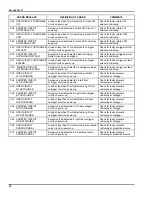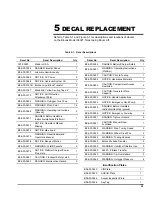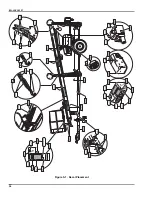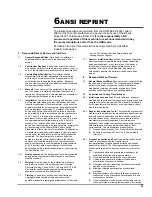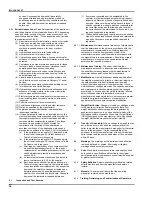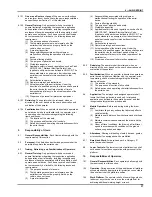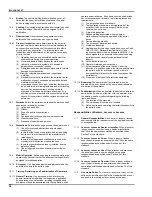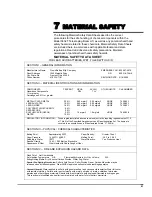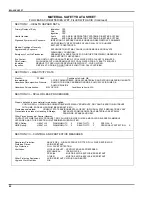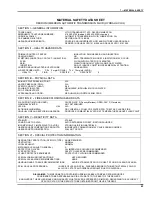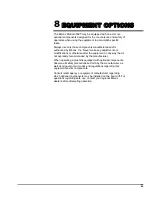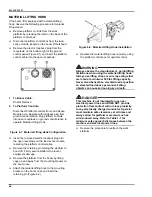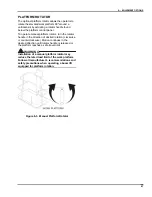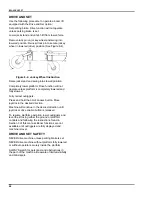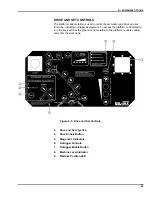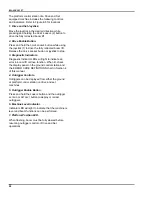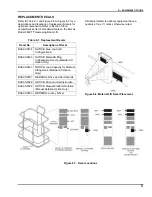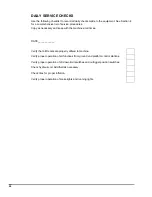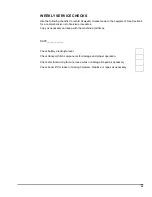
BIL-JAX 3632T
38
10.4
Brakes.
The vehicle parking brake(s) shall be set at all
times that the boom is elevated except when the aerial
device is being used in accordance with 9.5.
10.5
Loading.
Any loading which includes a horizontal load shall
be avoided unless the mobile unit is designed for that
application.
10.6
Observations.
Observations during operation for any
defects shall be conducted on an ongoing basis.
10.6.1
Pre-start Inspection.
Items determined by the owner in
accordance with the manufacturer’s recommendations for
each specific aerial device shall be inspected for defects
prior to each day’s operation. The following tests and
inspections shall be performed by the operator once daily,
prior to first use:
(1) Operating controls and associated mechanisms for
conditions interfering with proper operation.
(2) Visual and audible safety devices for malfunction.
(3) Hydraulic or pneumatic systems for observable
deterioration or excessive leakage.
(4) Fiberglass and other insulating components for visible
damage or contamination.
(5) Missing or illegible operational and instructional
markings.
(6) Electrical systems of/or related to the aerial device for
malfunction, signs of excessive deterioration, dirt and
moisture accumulation.
(7) Visual inspection of bolts, pins, and other fasteners for
loose, deformed or missing fasteners and other locking
devices. Any suspected items shall be carefully
examined or tested and a determination made by a
qualified person as to whether they constitute a safety
hazard. All unsafe items shall be replaced or repaired
before use.
10.7
Worksite.
Before the aerial device is used the worksite shall
be surveyed for hazards such as:
(1) Untamped earth fills.
(2) Ditches.
(3) Drop-offs and floor obstructions.
(4) Debris.
(5) Overhead obstructions and electrical conductors.
(6) Weather conditions.
(7) Presence of unauthorized persons.
10.8
Precautions.
Before and during each use the operator shall:
(1) Check for overhead obstructions and electrical
conductors.
(2) Insure that the load on the platform and/or load lifting
devices are in accordance with the manufacturer's
rated capacity.
(3) Insure that outriggers and stabilizers are used if the
manufacturer's instructions require their use.
(4) Insure that guardrails are properly installed, and the
gates are closed.
(5) Use outrigger pads when necessary to provide firm
footing.
10.9
Mobile Operation.
Before engaging in mobile operation the
operator shall determine that the aerial device is specifically
designed for mobile operation.
10.10
Personnel.
Only trained and authorized personnel shall be
permitted to operate the aerial device.
10.11
Training, Retraining, and Familiarization of Operators.
10.11.1
General Training.
Only personnel who have received
general instructions regarding the inspection, application
and operation of aerial devices, including recognition and
avoidance of hazards associated with their operation, shall
operate an aerial device. Such items covered shall include,
but not necessarily be limited to, the following issues and
requirements:
(1) The purpose and use of manuals.
(2) That operating manuals are an integral part of the
aerial device and must be properly stored on the
vehicle when not in use.
(3) A pre-start inspection.
(4) Responsibilities associated with problems or
malfunctions affecting the operation of the aerial
device.
(5) Factors
affecting
stability.
(6) The purpose of placards and decals.
(7) Workplace
inspection.
(8) Applicable safety rules and regulations, such as Part 4,
ANSI C2-1997, National Electrical Safety Code
(applies to utility workers as defined in ANSI C2). The
above standard is an example; other industries using
aerial devices have safety rules pertinent to that
industry.
(9) Authorization
to
operate.
(10) Operator warnings and instructions.
(11) Actual operation of the aerial device. Under the
direction of a qualified person, the trainee shall operate
the aerial device for a sufficient period of time to
demonstrate proficiency in the actual operation of the
aerial device.
(12) Proper use of personal fall protection equipment.
10.11.2
Retraining.
The operator shall be retrained, when so
directed by the user, based on the user’s observation and
evaluation of the operator.
10.11.3
Familiarization.
When an operator is directed to operate an
aerial device he/she is not familiar with, the operator, prior
to operating, shall be instructed regarding the following
items and issues:
(1) The location of the manuals.
(2) The purpose and function of all controls.
(3) Safety devices and operating characteristics specific to
the aerial device.
Responsibilities of Renters, Lessors or Lessees
11.1
General Responsibilities.
Each renter or lessor or lessee
shall comply with the requirements of the applicable section
or sections below.
11.1.1
Lessor or Lessee as Dealer or Installer.
When a lessor or
lessee uses the aerial device as a dealer or installer he
shall have the same responsibilities as specified under
Section 7 of this standard.
11.1.2
Lessor or Lessee as Owner.
When a lessor or lessee
uses the aerial device as an owner he shall have the same
responsibilities as specified under Section 8 of this
standard.
11.1.3
Lessor or Lessee as User.
When a lessor or lessee uses
the aerial device as a user he shall have the same
responsibilities as specified under Section 9 of this
standard.
11.1.4
Lessor or Lessee as Operator.
When a lessor or lessee
uses the aerial device as an operator he shall have the
same responsibilities as specified under Section 10 of this
standard.
11.2
Ownership Duties.
The renter or lessor shall carry out the
duties of ownership specified in this standard which are not
assigned to the renting entity or lessee as the user.
Summary of Contents for 3632T
Page 1: ...OPERATOR S MANUAL T 134 98 B33 01 0089 3632T ...
Page 42: ...BIL JAX 3632T 40 ...
Page 46: ...BIL JAX 3632T 44 ...

